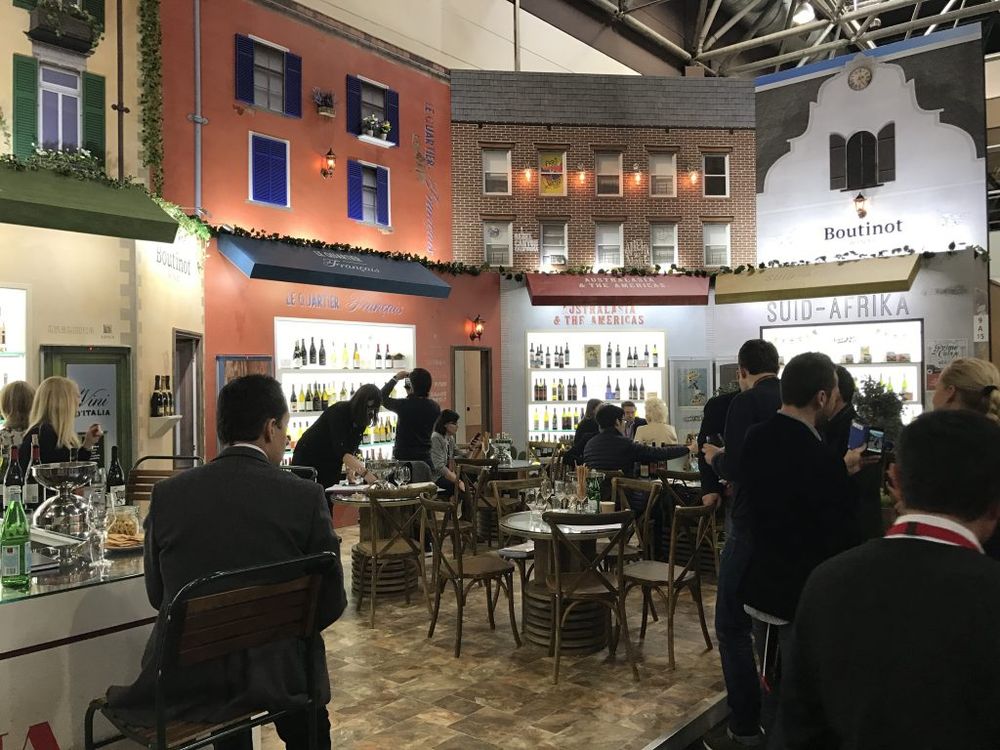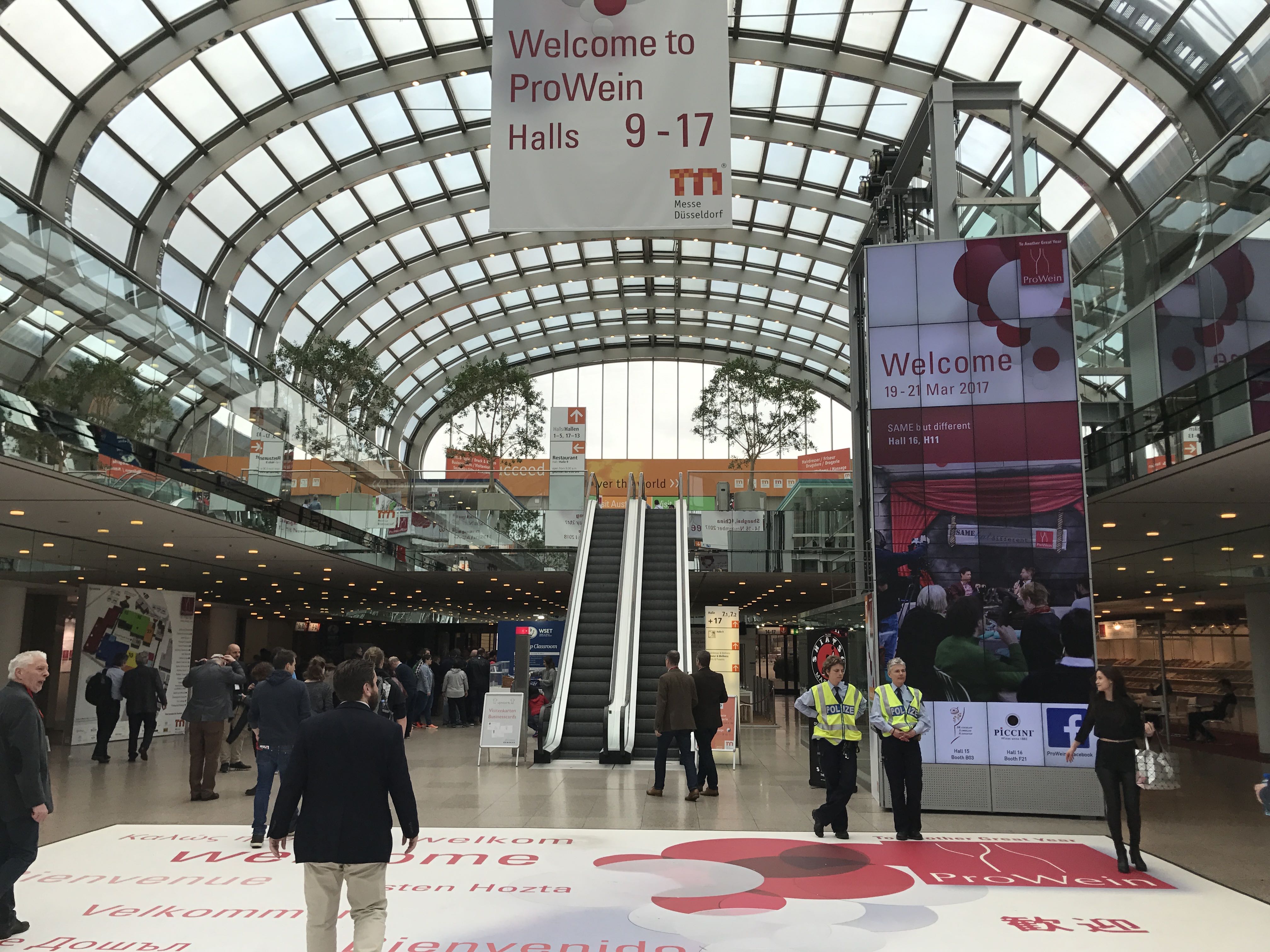What was really going on down the aisles and in the producer meeting rooms at Prowein? The Buyer was there to get the inside track.
The one thing that unites the thousands of buyers, retailers, importers, suppliers and producers who descend on Dusseldorf every year is finding new ways to buy wine. The need to do so at this year’s Prowein was even more intense than normal.
With only three days to play with it’s hard to peel back just a little of the outer skin of Planet Prowein. But what was clear, regardless of what brought you to the fair, this melting pot of wine business has just got a lot more competitive and even harder to stand out from the masses.
There was certainly a more serious mood at this year’s show. Less of the PR and flag waving, but a steely determination to rattle through meetings and get some business done.
There might have been a lot of wine available to taste, but there was far less to actually buy, hence the need to be on completely on top what you were doing, who you were talking to and where you were doing business.
The 10% drop plus in the total global wine harvest last year has put increased pressure on all areas of the supply chain. The talk by the bratwurst stands and the bars of the old town of Dusseldorf was of key shortages of grape varieties all over the world.
One leading UK importer jokingly asked if I could find him 1 million litres of Argentine Malbec by the end of the day.
Clearly the grape shortage is a short term problem and can be rectified to some extent by a strong 2017 harvest, but it could not have come at a worse time for most of the major wine producing countries who have been hit by currency shortfalls on the back of the political upheaval in the Northern Hemisphere.
Spectre of Brexit

Countries outside of the EU like South Africa are having to grapple with exchange rates to key export markets like the UK
This was the first Prowein where the spectre of Brexit lay heavily on proceedings. This is not just a UK problem, but a global issue considering how important the UK market is to so many wine countries and their producers, and the knock-on effect that then has on other wine markets around the world. The UK, after all, sits in the top three to five export markets for most of the mature wine producing markets.
Currency hits of 20% and more are having to be factored in to producer plans for 2017 and 2018 at least. Hits not all are going to be willing to take in the future.
Hits that could get worse before they get better with producers also concerned about the fall out from the forthcoming elections in France and Germany and subsequent impact on the value of the euro.
Whilst the UK will continue to be a key market, British importers, distributors and retailers are going to have to work a lot harder to find the wine they want at the price producers are willing to sell it for.
Until the full extent of the Brexit process is understood the UK is likely to become, literally, more of a shop window to the rest of the word. Still very important to be there, but being used far more strategically than in the past for particular projects, as producers look to free up capacity to service more profitable, more maturing markets.
It was very noticeable the number of producers that told The Buyer how they still saw the UK as a key “strategic” part of the business, but that they are now far more open about really driving business in other key markets around the world than they have in previous years.
It might take years for the full ramifications for Brexit to make any real difference, other than currency, on how producers work with the UK. But it is clear many are already acting now and making significant steps to lower allocations to the UK in favour of more profitable countries to work in, particularly China, Asia and the US.
It might, though, take some time for that wake up call to sink in amongst the bigger dominant UK players. Even though Prowein revealed research that producers surveyed at the show saw the UK as scoring high on the risk factor and low on attractiveness of doing business there.
Simon Thorpe, UK head of Negociants UK, the export arm of Australian producers Yalumba, noticeably said that we are probably too close to events to fully appreciate the scale of disruption that we as an industry are about to go through. A position that we are likely to be in for some time, which does give some advantage, he stressed to those suppliers that are supported by major producers – such as Yalumba – as they are able to take potentially a longer term view.
Year of change
But if you looked and listened carefully enough Prowein 2017 will be seen in years to come as the year that new lines were drawn in the sand and fresh strategies were drawn up.
Particularly in paying far more attention to really helping new and emerging markets, to grow that in the past were pushed on the back burner to keep up with demand from leading markets like the UK and northern Europe.
We can expect those emerging markets, particularly in Eastern Europe, to become more important as global producers look to find new markets and cover all bases in light of Brexit and fears of a more protectionist trading regime in the US.
Time and again producers spoke of fresh opportunities in the likes of Moldova, Macedonia, Slovenia, Slovakia, Kosovo and Poland. Russia is also now seen as being on the come back tail. All of which are seen as wine countries to source wine from and as key markets to do business in and sell wine to.
This is backed up by Prowein’s own research of its visitors that found two thirds of all buyers at the show are looking to introduce new countries to their ranges and not just go fishing where they have always bought wine. Which is just as well as 90% of the exhibitors are looking to expand the number of countries they service by 2020.
The research also found producers were particularly bullish about the economic opportunities in Russia, Hong Kong, Poland, South Korea, Brazil, China and the Scandinavian countries.
But were less enamoured by the prospects in the UK, France, Italy,Austria, and Belgium. A clear changing of the guard.
Countries deemed to have high attractiveness and low risk are Poland, Australia, Japan, Canada and the Scandinavian countries. Those that are high in attractiveness, but also high in risk are Russia, Brazil, China and Hong Kong.
Going direct

UK wine distributor, Boutinot, has long seen the importance of developing its export business around the world
We have already seen in the UK how many of the major retail players in both the on and off-trades are looking to go direct far more to the producers of scale they want to work with. Happy to increasingly cut importers, agents and distributors out of the loop and work with the producer alone. Or work far more in partnership with a select few wine suppliers who act as their sourcing, wine development arms on a more long term basis, building up their own ranges of own label and exclusive wines.
It was striking how different an interview with one of those key retailer supplier partners is compared to a wine business that is very much on the outside looking in. Not only are they, not surprisingly, on complete message about what those big retailers are looking for, they have a self confidence about what they are doing, the new brands they are bringing to market and are far more risk taking as a result. It is as if they are operating in a parallel trading environment to the rank and file of the wine trade.
UK export strategies
Equally this is having a knock-on effect on those wine distributors and suppliers who fear their bread and butter market with retailers in the UK is under threat and are now far more active and seriously about building up export markets of their own. Yes, there are still lots of UK companies travelling all the way to Dusseldorf just to have UK-only focused meetings, but you sense they will be increasingly missing out on new opportunities if they continue to do so in the future.
More UK wine suppliers, traditionally focused on their home market, are also now looking to spread their risk and build up their export strategies. Off Piste Wines, for example, believes it can build up 20% of its turnover overseas within four years and is already working in 11 countries in less than a year.
The likes of Off Piste, Ehrmanns and Copestick Murray are ideally placed to drive export strategies in that they have tried and tested brands in the UK market, like Most Wanted, Beefsteak Club and I Heart respectively. Varietal driven brands that also allow them to build up closer ties with producers in key wine making countries.
In summary
- Wineries and major producers are going to have to become more flexible, more diverse in the way they do business and not just rely on the normal way of doing things.
- Buyers, be they importers or the end retailer, have different needs and ways of selling wine and want to work with producers that can supply them wine in different formats and price structures. Some on long term deals, others on a tactical basis.
- For traditional wine suppliers and distributors the world is now a place for you to do business in and not just source your wine. An increasing number of UK suppliers, for example, were at Prowein developing their own export businesses and looking to sell wine in key developing countries around the world.
- Wine suppliers that have had success building up exclusive brands for retailers are now much better placed to try and find markets for those wines in export markets. Providing they own the IP and are able to adapt labels and styles to suit individual markets.
- It is now far more of a multi-channel business and the best producers will be the ones that can service major grocers and big direct to consumer websites with bespoke contracts, exclusive labels, bottled in market wines, whilst also having the capability to service more specialist, premium, independent retail and on-trade customers.
- More premium producers are looking to make bulk and contract wine services a much bigger part of their business. As the pressure on margin for their bottled wine tightens, using bulk and other ways of doing business allows them greater flexibility, and provides them with much needed cash flow and ways to use their inventory of wine production more efficiently.
This is an adapted and extended version of an article that was first published on VINEX, the bulk wine trading platform.










































